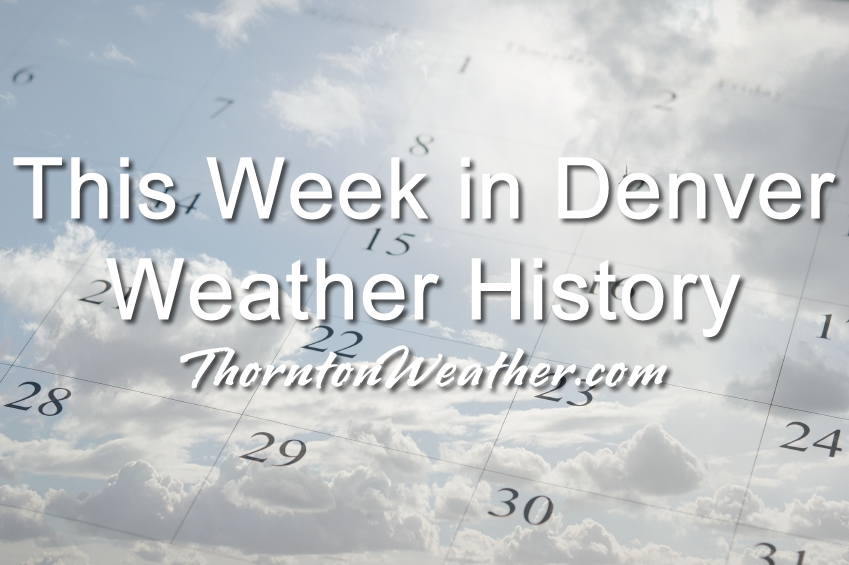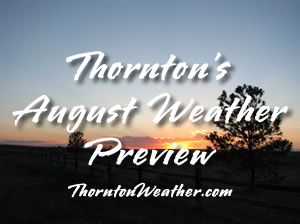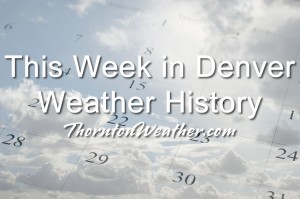
Denver and Colorado as a whole are known for their unusual weather. This week in particular is notable for one extraordinary event in weather history – clouds of grasshoppers!
8-10
In 1979…heavy thunderstorm rains on each of three consecutive days dumped a total of 2.22 inches of rain at Stapleton International Airport. The heaviest rain… 0.95 inches…fell on the 9th. Small hail to 1/8 inch diameter fell on the 8th.
8-13
In 1875…clouds of grasshoppers were seen flying through the air on the prevailing winds during each day.
9
In 1900…a thunderstorm produced west winds sustained to 47 mph with gusts to 55 mph…but only 0.01 inch of rain.
In 1902…a thunderstorm produced no rain and north winds sustained to 52 mph with gusts to 60 mph.
In 1934…heavy cloudbursts in the foothills near Kittredge and at the head of Mount Vernon creek caused flash flooding on both bear creek and Mount Vernon Creek at Morrison… Which resulted in 6 deaths and much property damage. The highway in Mount Vernon Canyon was destroyed by the flood waters.
In 1981…3/4 inch hail fell at Kittredge near Evergreen in Jefferson County.
In 1987…3/4 inch hail fell in Boulder and 9 miles northwest of Castle Rock.
In 1995…lightning struck a 16-year-old counselor in the back of the head while he and a friend were standing under a tree at the singing river ranch…7 miles west of Evergreen. He stopped breathing…but his friend was able to summon help and they were able to revive him. He was hospitalized for a few days and released.
In 1998…brief…weak tornadoes (f0) were sighted near Bennett and Roggen. No damage was reported. Hail as large as 1 inch diameter fell in Franktown with 3/4 inch diameter hail measured near Castle Rock. Thunderstorm winds gusted to 61 mph near Roggen.
9-10
In 2006…mid and high cloudiness overnight on both days resulted in two temperature records. The low temperature of 71 degrees on the 9th was a record high minimum for the date. The low temperature of 68 degrees on the 10th equaled the record high minimum for the date first set in 1936.
10
In 1924…0.01 inch of rain fell over downtown Denver. This along with the 0.01 inch of rainfall on the 4th was the only rainfall of the month…making this the driest august on record in the city.
In 1962…the high temperature reached 100 degrees at Stapleton Airport.
In 1970…hail stones to 1 inch in diameter were reported in the Fort Lupton area.
In 1972…dry thunderstorm microburst winds gusting to 46 mph briefly reduced the surface visibility to 3/4 mile in blowing dust at Stapleton International Airport.
In 1978…lightning struck two men in Aurora…killing one and injuring the other.
In 1982…a tornado was sighted near Castle Rock and remained on the ground for 10 minutes. Wind gusts to 60 mph were reported in Castle Rock. No damage was reported.
In 1994…heavy thunderstorm rains caused flash flooding on Lena Gulch in west metro Denver. Damage was estimated at 50 thousand dollars. Lightning struck a house in Westminster…causing a small attic fire.
In 1996…strong thunderstorm winds toppled a tent at a company picnic in Westminster. Five people received minor injuries when the tent collapsed. Two cars nearby were also damaged by flying debris. A weak tornado (f0)…first sighted near Denver International Airport…traveled east to near Bennett and Strasburg. No significant damage was reported.
In 1998…heavy rain caused flooding and flash flooding problems over southwest metro Denver. An observer in Lakewood measured 3.26 inches of rainfall in an hour. Several streets were flooded in central Lakewood. In addition…a trailer park along Lena Gulch in Wheat Ridge was evacuated due to high waters. One inch diameter hail fell near Roggen.
In 1999…thunderstorm-producing tornadoes…damaging straight line winds…heavy rain…and hail hammered metro Denver. In the city…small hail and heavy rainfall…up to 2.50 inches an hour…caused a 20-foot by 50-foot section of the roof to collapse at a furniture warehouse. Damage to the warehouse was estimated at 1 million dollars. Heavy rain also flooded several underpasses with up to 3 feet of water…which resulted in a number of stalled vehicles. In Fort Lupton…a tornado bounced across the area. Spotty damage was reported along a 5-mile path as trees…power poles…and lines were downed. In addition…an empty semi-trailer was overturned onto another vehicle northeast of the town. Thunderstorm winds gusted to 81 mph south of Fort Lupton.
In 2004…severe thunderstorms pummeled metro Denver with large hail. Hail up to 3 inches in diameter was measured 10 miles east of Castle Rock. Two inch diameter hail fell in Louisville…10 miles north of Hudson…and 1 mile east of Brighton. Hail to 1.75 inches was reported in Englewood… 1 mile south of Ft. Lupton…and 8 miles east of Boulder. Hail to 1.50 inches was reported around Boulder…near Broomfield…and in Lafayette…Thornton and greenwood village. Hail from 3/4 to 1 inch in diameter was found in Broomfield… Brighton…Castle Rock…Denver and Thornton…and near Longmont… Northglenn…Greenwood Village…Morrison…and Wheat Ridge. Severe thunderstorm wind gusts were recorded to 66 mph in Parker and to 60 mph 5 miles northeast of Boulder. There were no damage estimates from the hail or wind.
11
In 1872…fog was very dense until about 8:00 am. There was water dripping from the roofs of houses as if it had rained. The rain gage showed 0.01 inch of moisture…even though there had been no rainfall.
In 1927…an apparent dry microburst produced only a trace of rain and brief northwest winds sustained to 34 mph with gusts to 44 mph.
In 1980…hail up to golf ball size caused some roof and car damage in the southern part of Aurora.
In 1990…lightning ignited a storage tank filled with 10 thousand gallons of crude oil in a farmer’s field near Dacono…25 miles north of Denver. Flames shot to 40 feet high for nearly 2 hours before being extinguished. A lightning bolt also struck 21 miles north of Denver at an Erie fire station…causing extensive damage to the gas meter and electrical system. The sudden power surge blew out the station’s television set…a refrigerator…and a pop machine. Small fires spread throughout the structure… Totally destroying the building’s electrical wiring. The fires were quickly extinguished by the in-resident fire fighters. Golf ball size hail was reported in Denver near the intersection of Santa Fe drive and I-25.
In 1992…dime size hail fell in Westminster.
In 1994…strong thunderstorms produced large hail across northwest and north metro Denver. One inch diameter hail fell in Brighton with 3/4 inch hail reported in Westminster and at Indian Hills in the foothills west of Denver. Lightning struck a house in Arvada. The resulting fire destroyed one-third of the house. Funnel clouds were sighted over Westminster.
In 1997…large hail…strong winds…and torrential rains hammered portions of Lakewood and south Denver. Nearly 1 inch of rain fell in the span of 10 minutes in south Denver with a storm total of 1.81 inches. Street flooding was extensive as gutters and other drainage systems in the area were clogged by hail…piled several inches deep…and other debris. Strong thunderstorm winds to 50 mph and large hail accompanied by heavy rain caused extensive damage to cars…homes…and businesses. Several trees were downed by the strong winds…and trees were stripped of their leaves by hail. A water lily exhibition on display at the Denver botanic gardens was heavily damaged. Final estimates of the damage included 60 million dollars to automobiles and an additional 68 million dollars to homes and businesses. Hail to 1 1/2 inches in diameter fell in south Denver with 3/4 to 1 inch hail in Lakewood. A man received minor injuries in Aurora when he was struck by lightning while talking on the telephone.
In 2003…hail to 3/4 inch in diameter was measured in Aurora near Cherry Creek.
In 2012…a severe thunderstorm produced a wind gust to 60 mph at Rocky Mountain Metropolitan Airport
12
In 1876…the temperature climbed to a high of 100 degrees in downtown Denver.
In 1941…excessive thunderstorm rainfall flooded streets and delayed traffic for a few hours in some sections of the city. The basements of a considerable number of homes and commercial buildings were flooded. The total value of the damage was unknown. Only 0.94 inch of thunderstorm rainfall was recorded downtown.
In 1969…a man and a 9-year old boy were injured…when lightning struck a tree near where they were standing. Both were revived after treatment…but the boy later died of respiratory failure due to electrical shock.
In 1984…heavy thunderstorm rains drenched southern metro Denver. Rural roads in Douglas County received minor washouts. Hail…as large as 3/4 inch in diameter…was reported in southeast Aurora with one inch diameter hail reported near Parker. Rainfall totaled 1.00 inch at Stapleton International Airport.
12-13
In 1975…heavy rains caused flash flooding along the foothills from Denver north. Thunderstorm rainfall totaled 1.56 inches at Stapleton International Airport.
In 2004…a brief cool spell resulted in two daily temperature records. The low temperature of 49 degrees was a record minimum for the 12th…as was the low temperature of 48 degrees on the 13th.
13
In 1959…thunderstorm winds gusted to 53 mph at Stapleton Airport.
In 1983…thunderstorms dumped torrential rain in Northglenn… Thornton…and Broomfield. Northglenn was drenched with 1.72 inches in 30 minutes. Street flooding was widespread. Hail…as large as 3/4 inch in diameter…was reported 7 miles northeast of Boulder along with heavy rain which caused some street flooding.
In 2000…lightning sparked 3 small grass fires near Golden. The fires were quickly contained. Hail as large as 3/4 inch in diameter fell in Castle Rock.
14
In 1960…a bolt of lightning struck a man in Henderson… Causing serious burns.
In 1962…the temperature climbed to a high of 100 degrees at Stapleton Airport.
In 1968…a young man on a golf course in Denver was injured when lightning struck a tree under which he was standing. Lightning caused minor damage to a house in Denver. Heavy thunderstorm rain caused local street flooding. One inch diameter hail fell at Jefferson County airport near Broomfield.
In 1973…winds as high as 85 mph damaged 20 aircraft at the Arapahoe County airport…now Centennial Airport.
In 1977…three tornadoes were sighted in Bennett. A man suffered a broken leg when hit by a flying board. He was outside his camper home…which was destroyed. All windows were broken in a near-by farmhouse where some shingles were ripped off and a 2 car garage was knocked down. Several vehicles were damaged and a cat…some rabbits…and chickens were killed. A broken oar from a boat was driven into the side of a house. A mobile home was overturned. One old barn was destroyed. Half a dozen homes and several agricultural buildings were damaged just west of State Highway 79.
In 1978…high winds produced much blowing dust…causing many traffic accidents in the Denver-Boulder area. Winds gusts of 70 to 101 mph were recorded. Northwest winds gusted to 44 mph at Stapleton International Airport.
In 1980…lightning hit two power poles in Littleton…causing 400 dollars in damage. Rainfall of 1.23 inches in a short time caused minor flooding…which included damage to a ground floor apartment and partially submerging a few vehicles in water. Thunderstorm rainfall totaled 0.98 inch at Stapleton International Airport.
In 1983…2.10 inches of rain drenched Golden in an hour with similar amounts in Lakewood and Boulder. Over ten thousand dollars worth of plants were washed away at a nursery in Lakewood.
In 1997…twelve motorists were injured in a multi-car accident when strong microburst winds estimated to 50 mph blew blinding dust across I-70 near Bennett.
In 1998…lightning struck a hydro-electric plant in Nederland… Causing a power outage. Residents in the foothills west of Boulder…including Nederland…Ward…Eldora…Jamestown… And Gold Hill…were without power for about an hour.
In 2006…heavy thunderstorm rainfall near Deckers washed away some the banks along State Highway 67 between Deckers and Westcreek. Several driveways on both sides of the highway were also damaged.
15
In 1899…a thunderstorm produced southwest sustained winds to 43 mph with gusts to 46 mph.
In 1972…a pilot reported a funnel cloud briefly touching the ground in open fields…17 miles east-northeast of Stapleton International Airport.
In 1980…thunderstorm winds gusted to 55 mph in Boulder.
In 1982…brief heavy rain and winds estimated as high as 70 mph occurred in the Conifer-Evergreen area. No damage was reported.
In 1990…lightning triggered a small attic fire in a house near Sedalia…20 miles south of Denver. A furious lightning storm caused widespread power outages across southern sections of metro Denver. One lightning bolt knocked out an electrical substation…causing a 90-minute blackout in southeast Denver affecting nearly 10 thousand homes and businesses.
In 2007…severe thunderstorms produced large hail…up to 2 inches in diameter…near larkspur. Extensive damage to vehicles in the area was reported. In Parker…lightning struck a residence. The ensuing fire damaged the attic and top floor; causing $100…000 in property damage.
In 2008…at least three homes were hit by lightning during the early morning hours in Arapahoe County. Lightning also struck two homes in Castle Rock…damaging the roofs.
In 2013…a dry microburst uprooted 30 to 40 large trees across a 12-block area of the Park Hill neighborhood in east central Denver. Several trees were snapped near the base along with numerous branches…8 to 10 inches in diameter. Power poles and lines were also downed with resulted in outages which affected seven hundred residents. One of the downed trees crushed a car`s hood… Narrowly missing the driver. At Denver International Airport…a peak wind gust of 22 mph was observed from the southwest.





